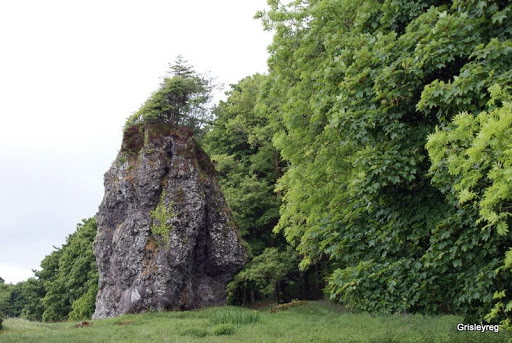To attempt this cache the best place to park is on the sea front parking just outside the Dunollie lighthouse park and walk towards the lighthouse. Here you will come across an information board which will provide you with all the information you will need to log this cache. If you look to your right across the road you will see the Dogstone in the park/woodland walk which can be accessed by turning back towards the gate and crossing the road.

To log this cache you will need to gather the information off this geopage and answer the following questions:
In the field between here and Duniolle Castle stands Clach a' Choin, the "Dogstone". Legend has it that this was where the ancient heroic warrior of Celtic mythology Fionn Maccumhail (Fingal) would chain his massive Dog Bran. As it circled and struggled it wore a groove around the base of the stone with its colossal chain and they say you can still hear its ghostly howls.
Science tells us that the Dog Stone is made from rock known as Conglomerate, deposited about 415 million years ago. Much later, around 12,000 years ago, Dunollie Point was surrounded by sea after the last Ice Age and the shape of the Dog Stone was gradually created by the tide and weather, especially frost freeze thawing actions. As the ice, which was almost 2 km thick and very heavy, melted inland the tectonic plates rose up creating the hundreds of raised platforms and beaches that can be seen along the coastline. The coast line with the Dog Stone also rose leaving the eroding forces of the seas behind and capturing the shape of the Dog Stone at that moment in time.
Conglomerate is a rock consisting of individual clasts within a finer-grained matrix that have become cemented together. Conglomerates are sedimentary rocks consisting of rounded fragments and are thus differentiated from breccias, which consist of angular clasts. Both conglomerates and breccias are characterized by clasts larger than sand (>2 mm). Weathering is the breaking down of rocks, soil and minerals as well as artificial materials through contact with the Earth's atmosphere, biota and waters. Weathering occurs in situ, roughly translated to: "with no movement" , and thus should not be confused with erosion, which involves the movement of rocks and minerals by agents such as water, ice, snow, wind, waves and gravity and then being transported and deposited in other locations. Two important classifications of weathering processes exist – physical and chemical weathering; each sometimes involves a biological component. Mechanical or physical weathering involves the breakdown of rocks and soils through direct contact with atmospheric conditions, such as heat, water, ice and pressure. The second classification, chemical weathering, involves the direct effect of atmospheric chemicals or biologically produced chemicals also known as biological weathering in the breakdown of rocks, soils and minerals. While physical weathering is accentuated in very cold or very dry environments, chemical reactions are most intense where the climate is wet and hot. However, both types of weathering occur together, and each tends to accelerate the other. For example, physical abrasion (rubbing together) decreases the size of particles and therefore increases their surface area, making them more susceptible to rapid chemical reactions. The various agents act in concert to convert primary minerals (feldspars and micas) to secondary minerals (clays and carbonates) and release plant nutrient elements in soluble forms. The materials left over after the rock breaks down combined with organic material creates soil. The mineral content of the soil is determined by the parent material, thus a soil derived from a single rock type can often be deficient in one or more minerals for good fertility, while a soil weathered from a mix of rock types (as in glacial, aeolian or alluvial sediments) often makes more fertile soil. In addition, many of Earth's landforms and landscapes are the result of weathering processes combined with erosion and re-deposition.
Question 1: Describe the Dogstones appearance to us? Colour, texture etc.
Question 2: What type of action created the Dogstone and is this classed as weathering, erosion or both?Explain.
All answers need to be emailed to us to log this cache and please attach any photos and stories of your visit to your log so we can see your adventures in the area.